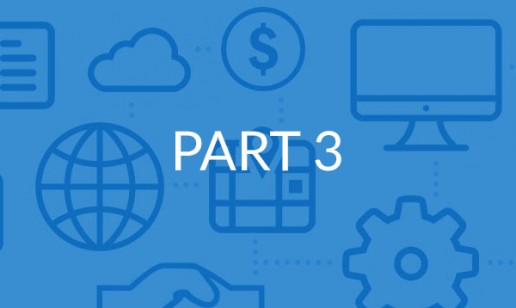More than a buzzword: Programmatic (Part 4: Control)
After identifying programmatic control issues in our last installment of More than a buzzword — we’re now ready to explore the solutions. By offering control to publishers and advertisers, programmatic advertising can execute enormous numbers of transactions with ease, speed and improved efficiencies making it the optimal tool for improving the bottom line in digital media.
“Programmatic can only be effective when the control levers are handed over to buyers and sellers,” explains Jagdish Narigara, ClearPier’s director of product management, “Platforms need to act as more than a service provider — they need to step up and mentor customers, facilitate deal conversations, provide smart insights, act as a neutral third party to manage digital assets as well as executing transactions per contract.”
When it comes to targeting a direct audience, programmatic is the clever solution for both advertisers and publishers as it’s best for direct response.

Let’s take a look at the publisher’s perspective
With more and more publishers getting on board with programmatic opportunity, folks are starting to understand the potential of optimizing their sales channels through this method.
When it comes to solutions for control, this is what publishers seem to desire:
- — Protection against inventory commoditization and price dilution while operating on automated algorithms
- — Establishing a managed gateway in efforts to provide single point of entry for every approved buyer where the inventory is traded at real-worth
- — To sell differentiated inventory through appropriate sales channels — they want to define buyer access priorities, bid bias and selling rules. Essentially enabling publishers to have their say in automated decision making processes at every sales decision
- — To define and implement quality standards for creative using programmatic controls to deliver safe and pleasant brand experiences
- — Control over their data — enforce stringent consumption policies and protect data leakages. “This is just pre-requisite,” says Narigara, “This would motivate them to overlay their first-party data over programmatically learned data and run audience-extension programs on programmatic. This is otherwise hard to imagine.”
- — Access to their performance and transaction logs to derive smart insights to validate and realign their programmatic strategy
- — By gaining control over propensity and probability acumen generated by programmatic algorithms, they want to produce more relevant and rewarding content to take their businesses to new levels.
Then there’s the advertiser’s perspective
“Advertisers have already tasted the fruits of programmatic,” says Narigara about programmatic’s growth in the industry, “They have an unmatched platform to justify and attribute every dollar spent.”
Programmatic is on the rise and is taking the advertising world by storm. In fact, according to a recent survey by World Federation of Advertisers (WFA), surveyed brands have doubled their investments in programmatic ad trading year on year and 44 per cent of their programmatic budget is targeting online display advertising.
“Advertisers want to take control back from the Trading Desks and intermediaries by establishing their independent Trading Desks (ITDs) and Demand-side Platforms,” says the WFA report, “And they have started moving towards that. In 2014, 30% of the surveyed brands have started using them.”
Highlighted solutions for advertisers are:
- — Offering bidding platforms with different objectives — from profit maximization and CTR maximization to win percentage maximization. The idea of having bidders aligning their objectives with impression bids in efforts to deliver advertiser objectives (not DSP’s/ATD’s)
- — Control over inventory selection; organized to avoid irrelevant queries with the ability to select which inventory to buy and ignore — they want to define inventory criteria via programmatic and expect machines to honour that
- — Protection against fraud — a programmatic platform that can help advertisers distinguish between human versus fraud traffic
- — Access to a publisher’s premium and guaranteed supply — and they want it through Unified Holistic Auction with multiple bid options for each tier of inventory. According to Narigara, auctions are currently taking place in Silos.
- — Advertisers also want access to their transaction logs, bid landscape, performance insights, conversion funnel discernibility and success/failure analysis — in efforts to derive new intelligence and better strategies and operations
Programmatic is the future of digital advertising.
“It is still in nascent stage, when it is implemented in its true sense, it will take the industry to new horizons!” says Narigara.
Share
[sgmb id=”1″]
More than a buzzword: Programmatic (Part 3: Control)
Having addressed issues and solutions with transparency, More Than A Buzzword is now focusing on issues with control in regards to programmatic advertising.
Programmatic isn’t just technology, it’s a business solution to Jagdish Narigara, ClearPier’s director of Product Management.
“It gives immense opportunity to define, implement and execute innovative business strategies — enabling innovative business models to tap into hidden potentials in media buying and selling,” says Narigara, “As with every business avenue, there comes issues with control.”
Both publishers and advertisers want control — but there are concerns from each side when opting for programmatic. Let’s take a look at some of the issues that may arise.
From the publishers perspective
For publishers who are looking to restructure and re-strategize their premium, exclusive and guaranteed sales channels, programmatic can help tap into that with high potential.
“Programmatic can bring synergies to enable holistic impression monetization strategy across different tiers of inventory,” says Narigara.
But there are still challenges in terms of control that publishers may face when operating programmatic.
There are concerns surrounding the possibility of machines eroding value — value being channel, content, audience or inventory, according a survey of AOL Platform Clients. This survey also revealed that 54% of publisher executives still have concerns/ambiguity over control provided by programmatic platforms.
“Publishers with strong brands, quality environments and great content are often frustrated with programmatic because it tries to treat their differentiated product as a commodity! It is the same as treating a Styrofoam tomato from a fast food chain as if it was an heirloom tomato from Whole Foods,” says Pam Horan, president of Online Publishing Association, “Ad environments are not a commodity! Great media brands frame the marketer’s ad within a strong consumer relationship. Publishers need control over managing the entry point, inventory and price.”
Publishers also want control over which types of ad creatives that are allowed to run on their sites. With stringent creative guidelines, publishers want to be confident in machine-based decision-making platforms when it comes to what, where and how ads are being placed.
Then, there are some publishers who are dubious when it comes to relinquishing control over their data. “They fear that if this data is exposed to programmatic decision making and ad serving algorithms, they will have no control over other parties obtaining the data in the lengthy value-chain,” explains Narigara.
Advertisers are also being held back from fully embracing the programmatic approach.
With 33% of advertiser panelists stating that brand safety issues are actively inhibiting the adoption of programmatic approaches because of decreased control over where their advertising may be viewed, according to the IAB and Winterberry Group survey — control issues with programmatic are also of concern from the advertisers front.
Advertising spend risks include: ad-stacking, bots and un-viewable placements.
Due to the lack of audit measures when it comes to inventory running through programmatic platforms, confidence in the inventory and its source end up in question.
“There is still a gap between the owner of the impression and seller of the impression,” says Narigara, “Because of this, advertisers may suffer.” Metrics may be impressive, but the actual impact may be mediocre.
With Internet users getting more savvy, there are growing concerns when it comes to reach. “Out of 5.3 trillion display ads served in 2013, only 2 out of 20 web users clicked on the ads. Moreover, annoyed with the distracting animations and sounds of ads, people are responding by blocking ads altogether,” A Shopparity survey reported, “22.7% of web surfers have already installed ad blockers and the use of ad blockers is growing over 40% year over year.”
This leaves us with a couple big questions: can we restore the interest of consumers and can programmatic revive the advertising industry?
In our final installment of More than a buzzword, we’ll explore programmatic control solutions.
Share
[sgmb id=”1″]
More than a buzzword: Programmatic (Part 2: Transparency Solutions)
While we highlighted issues with transparency in our previous installment, this edition centers on solutions with transparency when it comes to programmatic dealings for both publishers and advertisers.
Involved in solving these daunting issues with programmatic transparency is our in-house expert, Jagdish Narigara, ClearPier’s director of product management. With experience, knowledge and genuine interest in ad tech, Narigara was able to provide much insight.
Next generation advertising solutions in private marketplaces?
“Various SSPs and Exchanges have invested their resources into the next generation of advertising solution such as private marketplaces,” notes Narigara, “[they] have invested their resources into this but the direction is not cohesive — everyone is heading this effort to their own perception of the opportunity.”
By meeting expectations of providing transparent, fair eco-systems — publishers can ease the struggle of identifying solid partnerships in advertisers. It’s important to offer visibility when it comes to who is buying their digital assets, at what prices and via which channel.
Transparency across the value chain is necessary — publishers should not only expect visibility into the buyer pool, brand safety, creative quality and protecting channel conflict — they should receive it. The solution in short? Only publisher approved buyers should have access to their inventory at the price specified by the publishers with the stipulated order of priority to each buyer and channel.
IAB suggets the net effect of transparent fee and margin policies for publishers is that buyers and sellers will be able to evaluate ROI based on “more accurate information, minimizing situations where they wrongly value the programmatic opportunity in addition to promoting more active participation in the auction environment.”
Advertising agencies also benefit from transparency
“Advertisers and agencies expect programmatic to provide transparency in terms of inventory, inventory source, quality and niche targeting and media cost,” says Narigara.
Platforms that promise only approved partners, and deliver site and page URLs, fold position and specific placement to ensure brands are landing with accuracy in terms of content and users, is a transparency solution.
“To gain confidence and motivate buyers and sellers, programmatic platforms should articulate and implement data storage,” says Narigara, “Management and consumption policies in consultations with buyers and sellers.”
It’s important that programmatic platforms be transparent as they capture, provide performance insights from different dimensions, bidding landscapes that show winning/losing bids, audience segments to attributing events and specific placements.
Narigara thinks programmatic is more than executing transactions in an automated fashion — it’s about unlocking great insights and having potential to drastically revamp digital media buying and selling strategies.
“Programmatic is not just the technology, it is the means of fostering trust, building relationships and enriching buying-selling experiences!”
Share
[sgmb id=”1″]
More than a buzzword: Programmatic | Part One: Transparency
With programmatic being all the rage in both Europe and North America, it’s important to note that while it’s becoming a trendy buzzword — it’s actually an incredible tool that provides benefits to both publishers and ad agencies.
In this four part blog series More than a buzzword: Programmatic transparency and control — we are going to identify both issues and solutions when it comes to this booming ad tech trend.
We had an opportunity to talk to our own expert, Jagdish Narigara, ClearPier’s director of product management on all of these issues.
Issues with transparency
An AOL survey conducted in August 2014 on programmatic revealed inventory quality and transparency (or lack thereof) are the top concerns of Publishers and Advertisers, with more than 60 per cent of execs in both camps being concerned.
“[From the] publisher’s perspective — they should be able to monetize their inventory with trusted partners (good quality advertisers) and be aware of hidden costs of selling the impressions on platforms that claim to be programmatic,” says Narigara, “From the advertiser’s perspective, they should be able to buy quality inventory from the trusted partners with full visibility into where their ads are getting displayed.”
In fact, earlier this year ANA & FORRESTER’s survey of 153 marketers showed advertisers had concerns about the level of transparency provided by current programmatic platforms —42 per cent said their concerns increased in the last year.
Issues highlighted in September’s World Federation of Advertisers (WFA) were as follows:
- – Half of the respondents said they weren’t happy with the way data is captured, store and used
- – 85 per cent were concerned with ad placement
- – 64 per cent of the polled current programmatic practices such as “arbitrage” were unacceptable and they were not happy with the mark-ups on inventory
- – Concerns with bot traffic (20 per cent of all online display and mobile ad impressions have been deemed ‘invalid’), according to the report
Back in March, ANA & FORRESTER released a survey that indicated top issues related to transparency reported by advertisers were the visibility into targeting data (49 per cent) and understanding ad placement (43 per cent). According to the port, the advertiser’s concerns are as follows:
- – Served versus viewable impressions for digital media.
- – Media rebates to agencies.
- – Masking of Digital ad placement (e.g., frequency caps, inappropriate content, share of voice, above-the-fold, etc.).
- – Lack of visibility into data used to define audience targeting.
“While potential of Programmatic is tremendous, lack of implementation of transparent ecosystem by Platforms is hampering its effectiveness,” says Narigara, “When implemented in its true sense, Programmatic can uncover hidden horizons!”
NEXT –> Solving issues of programmatic transparency
Share
[sgmb id=”1″]





